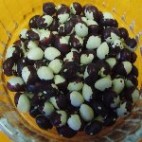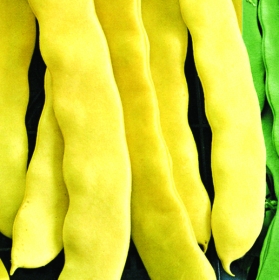Growing French Beans
One of the easier vegetables to grow, French beans are also ideal for the smaller allotment as you get a lot in a small space. Here we explore the pros and cons of some of the different varieties.
|
Green beans may escape your notice among the leaves, but tend to be heavier cropping than coloured varieties.
|
. . . and what happens when you cook them? Well, the purple ones go to a dark green (leaving behind the most alarmingly coloured cooking water!) but the golden ones stay gold.
CLIMBING VERSUS DWARF?
Of course, if you grow climbing beans you'll have to build a wigwam or row with canes. So it may seem obvious that dwarf beans are better. Not necessarily. Dwarf beans crop all at once in one mad rush, and then are over, so you need to plant a succession of short rows. Climbing beans crop for longer, and are more measured about it. You may well be able to have just the one row to keep you going through the summer.
One of the big annoyances with french beans is that slugs and snails just love them. Especially in damp weather, you'll find the local mollusc population are queuing up to nibble the ends of the beans where they hang low down near the ground. With climbing beans, all but the first few are too high up for them to reach.
And then there's your back . . . it's much easier to pick climbing beans!
French beans are tender, so to get an earlier crop you can start off plants in the greenhouse. You will need fewer plants if you are growing a climbing variety, than if you are growing dwarf.
Dwarf french beans have an irritating habit of pushing themselves up out of the ground. You can help by earthing up the rows slightly as the plants grow, but in windy weather the rows can be blown about so much that the plants' roots get damaged and they fail. It's all too easy, as well, to pull them accidentally out of the ground when picking the crop. Climbing beans have the support of the pole and this isn't so much of a problem.
THE VERDICT? YOU CAN GROW THE GREATEST QUATITIES BY SOWING A SUCCESSION OF SHORT ROWS OF DWARF BEANS. BUT CLIMBING BEANS ARE PROBABLY EASIER TO MANAGE.
Of course, if you grow climbing beans you'll have to build a wigwam or row with canes. So it may seem obvious that dwarf beans are better. Not necessarily. Dwarf beans crop all at once in one mad rush, and then are over, so you need to plant a succession of short rows. Climbing beans crop for longer, and are more measured about it. You may well be able to have just the one row to keep you going through the summer.
One of the big annoyances with french beans is that slugs and snails just love them. Especially in damp weather, you'll find the local mollusc population are queuing up to nibble the ends of the beans where they hang low down near the ground. With climbing beans, all but the first few are too high up for them to reach.
And then there's your back . . . it's much easier to pick climbing beans!
French beans are tender, so to get an earlier crop you can start off plants in the greenhouse. You will need fewer plants if you are growing a climbing variety, than if you are growing dwarf.
Dwarf french beans have an irritating habit of pushing themselves up out of the ground. You can help by earthing up the rows slightly as the plants grow, but in windy weather the rows can be blown about so much that the plants' roots get damaged and they fail. It's all too easy, as well, to pull them accidentally out of the ground when picking the crop. Climbing beans have the support of the pole and this isn't so much of a problem.
THE VERDICT? YOU CAN GROW THE GREATEST QUATITIES BY SOWING A SUCCESSION OF SHORT ROWS OF DWARF BEANS. BUT CLIMBING BEANS ARE PROBABLY EASIER TO MANAGE.
As well as the familiar french beans you see in the shops, there are other beans which can be grown either to eat 'green', or for use as podded beans - either as soon as they are ripe, or dried for the winter. Here are a selection you may not have considered growing . . .
All the above courtesy of Tuckers - click on the pic for a link.
Below are some exciting varieties from Seeds of Distinction!
Below are some exciting varieties from Seeds of Distinction!











